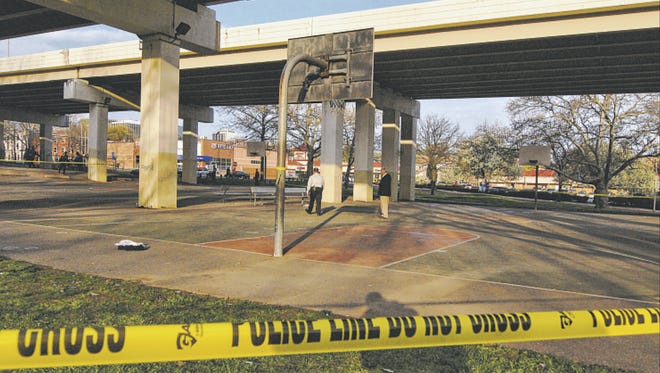It's past time for Delaware to act on Wilmington violence: Editorial

Wilmington now has the dubious distinction of being the city in America where teenagers are most likely to get shot.
In this awful ranking of blood in America’s streets, Delaware’s largest city leads by a mile. Teenagers in Wilmington are more vulnerable to gun violence than kids in Chicago, thought of as the nation’s most dangerous metropolitan area.
It is way past time for a change in Wilmington. Big, bold and meaningful action is needed immediately.
Delaware’s governor, Wilmington’s mayor and the New Castle County executive should immediately pull together the $1 million to $2 million needed annually to fund the teen violence plan created specifically for the city by the Centers for Disease Control and Prevention.
That price tag is less than a hundredth of one percent of the state’s annual $4 billion budget. Surely with the city’s $150 million budget, and the county’s $180 million spending plan, enough money could be cobbled together to fund the CDC plan.
It appears to be one of the best approaches to making teens safer –– and diminishing the negative image that gives new businesses pause about locating here.
Gov. John Carney told The News Journal he would not support investing further state money into Wilmington without assurances it would be spent wisely. That’s understandable, admirable.
This is about setting priorities for one of Delaware’s biggest issues, not spending more taxpayer money. How many more black children must suffer gunshots before the governor’s fiscal conditions are met?
We have to wonder if the lack of urgency stems from not understanding what it’s like for kids worried about getting shot on any given day.
Have Delawareans become inured to the plight of those trapped in some of Wilmington’s toughest neighborhoods, where an average of four shootings a week take place?
Last Monday, a shooting occurred in the Little Italy neighborhood, demonstrating how shockingly commonplace the gun violence epidemic has become.
A young man ran down the 1900 block of Fifth Street holding a gun at his side, then stopped in front of a row home and fired multiple rounds into the structure where two teens had only seconds earlier entered.
On the front porch of a house nearby, a family was enjoying the afternoon while children played catch football on the street. A 5-year-old girl pushed her scooter on the sidewalk as the gunman fired, and she was struck by a bullet that ricocheted off the brick house.
Stories like this should sear our consciences, spur us to act.
We know that the CDC’s recommendations, alone, will not halt the senseless gun violence overnight. But the failure to implement such a straightforward, relatively inexpensive solution is emblematic of our state's fatal inertia.
If we can’t tackle this, how can we begin to fix the city’s failing public education system that also contributes to crime?
Too many kids in Wilmington’s schools have suffered the psychological trauma of incessant gun violence, and many lack basic human needs.
That makes educators’ jobs almost impossible. In 2014, only 68 percent of students living in Wilmington graduated high school on time.
It’s not surprising that those who don’t make it through high school are more than 63 times more likely to end up in jail than college graduates, according to a Northeastern University study.
In Delaware, only 26 percent of children are black, yet they make up 64 percent of young people arrested for crimes – and many of them come from Wilmington.
To make progress, we need a unified effort from political, religious and law enforcement leaders, nonprofits, educators and citizens.
The CDC plan is a good place to start. And we need leadership to shake off the rust of inaction.
It’s been four years since Wilmington asked for help from the federal agency that normally uses its investigative teams to determine whether environmental conditions are causing health issues such as cancer clusters. The agency said Wilmington was suffering an “epidemic of urban gun violence,” and its prescription was simple:
Create a database that allows state agencies to share information about children –– including school truancy records, child welfare reports, emergency room visits and the death of a family member or friend. This data would be shared with a team trained to intervene on the child’s behalf before he or she gets into serious trouble.
These kids also need mentors, coaches and role models, the CDC, said, which is where average citizens can make a difference.
Nearly all the city’s youth gun violence involves African-American teens –– as shooters and victims.
The Rev. Donald Morton of Tabernacle Baptist Church said the teens pulling triggers know “there are only two roads that this leads to ––death and prison. And both those roads, the young people are not afraid of. It just doesn’t matter to them anymore.”
This brutal reality should hurt all Delawareans. And we should harness the pain that comes with Wilmington being the most dangerous place for teens in America, turn it into a movement to heal the city.
We can’t let this moment pass, as we did in 2014 when Newsweek magazine labeled Wilmington “Murdertown USA,” and ABC later announced it would was considering a TV show based on our struggles.
Delawareans did not like that negative blot on the brand of our biggest city, and leaders said we had to do something, “because as goes Wilmington, so goes Delaware.”
But we didn’t do anything consequential. And the gun violence got worse.
As long as Wilmington bleeds, we cannot be proud of Delaware. It’s time to act.
The News Journal's editorial opinions are decided by its editorial board, which is separate from the news staff.